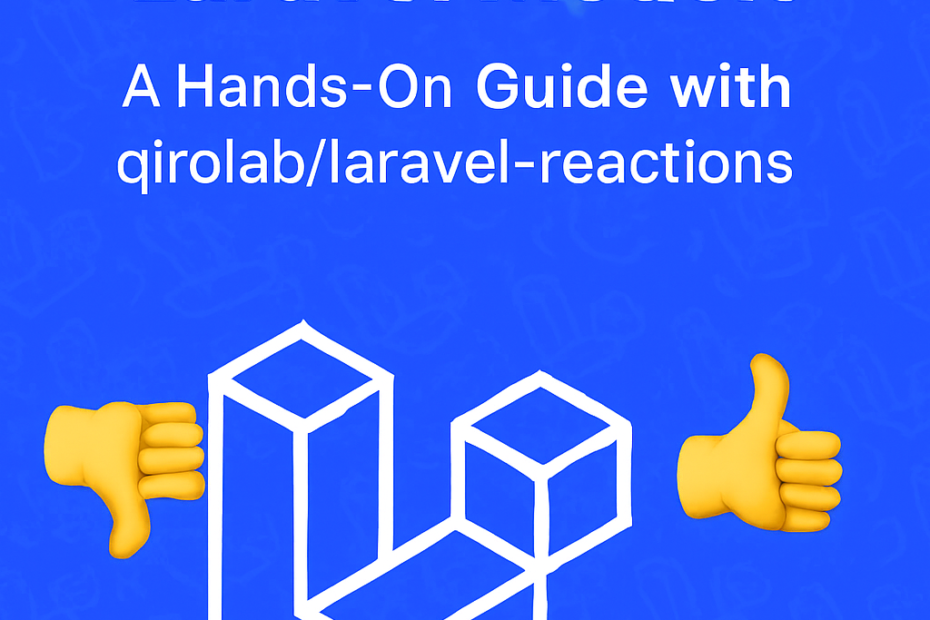In today’s digital landscape, user engagement is everything. Whether you’re building a blog, forum, or social platform, allowing users to express themselves through reactions—like 👍, 👎, ❤️, or 😂—can dramatically boost interaction. In this guide, we’ll walk through how to add reaction functionality to any Laravel model using the brilliant qirolab/laravel-reactions package.
🧰 Why Use qirolab/laravel-reactions?
This package offers:
- Plug-and-play reaction support for Eloquent models
- Multiple reaction types (like, dislike, love, etc.)
- Easy integration with existing user and content models
- Clean API for adding, removing, and toggling reactions
Let’s dive in.
⚙️ Step 1: Install the Package
Run the following command in your Laravel project:
composer require qirolab/laravel-reactionsLaravel 5.5+ supports auto-discovery, so no need to manually register the service provider.
🗃️ Step 2: Publish and Run Migrations
To create the necessary tables:
php artisan vendor:publish --provider="Qirolab\Laravel\Reactions\ReactionsServiceProvider" --tag=migrations
php artisan migrateOptionally, publish the config file:
php artisan vendor:publish --provider="Qirolab\Laravel\Reactions\ReactionsServiceProvider" --tag=config👤 Step 3: Prepare the User Model
Your User model needs to implement the ReactsInterface and use the Reacts trait:
use Qirolab\Laravel\Reactions\Traits\Reacts;
use Qirolab\Laravel\Reactions\Contracts\ReactsInterface;
class User extends Authenticatable implements ReactsInterface
{
use Reacts;
}📄 Step 4: Make Your Model Reactable
Let’s say you want users to react to Post models. Update your Post model like this:
use Qirolab\Laravel\Reactions\Traits\Reactable;
use Qirolab\Laravel\Reactions\Contracts\ReactableInterface;
class Post extends Model implements ReactableInterface
{
use Reactable;
}💡 Step 5: Add Reactions in Action
Here’s how users can react to posts:
$user->reactTo($post, 'like'); // React with 'like'
$post->react('dislike', $user); // React with 'dislike'To remove a reaction:
$user->removeReactionFrom($post);
$post->removeReaction($user);To toggle reactions:
$user->toggleReactionOn($post, 'like');If the user already reacted with ‘like’, this will remove it. If not, it will add it.
📊 Step 6: Querying Reactions
You can fetch reaction data like this:
$post->reactionCounter; // Total reactions
$post->reactions; // All reactions
$post->reactedBy; // Users who reactedTo check if a user reacted:
$post->isReacted($user); // true or false🧪 Bonus: Testing with Laravel Dusk
Since you’re big on automated testing, here’s a quick Dusk snippet:
public function test_user_can_like_post()
{
$user = User::factory()->create();
$post = Post::factory()->create();
$this->browse(function (Browser $browser) use ($user, $post) {
$browser->loginAs($user)
->visit("/posts/{$post->id}")
->press('Like')
->assertSee('You liked this post');
});
}🎯 Final Thoughts
The qirolab/laravel-reactions package is a lightweight yet powerful way to add expressive features to your Laravel app. Whether you’re building a social feed or a comment system, reactions can make your platform feel more alive.
Fuel my creative spark with a virtual coffee! Your support keeps the ideas percolating—grab me a cup at Buy Me a Coffee and let’s keep the magic brewing!
